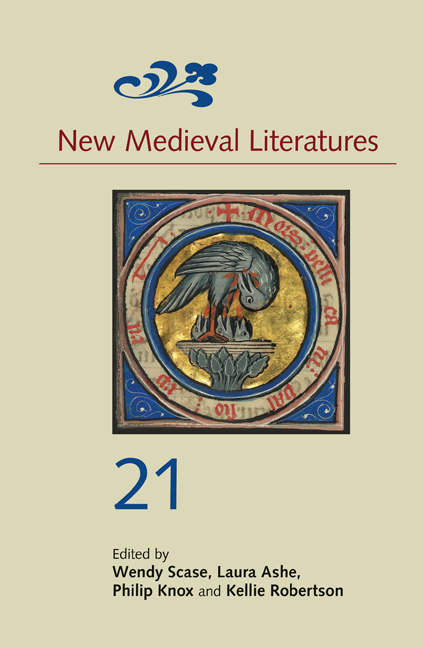Book contents
- Frontmatter
- Contents
- List of Illustrations
- List of Abbreviations
- 1 ‘Chevaliers estre deüsiez’: Genealogy and Historical Sense in Chrétien de Troyes’s Conte du Graal
- 2 English Vernacular Script in the Thirteenth Century (c.1175–c.1325)
- 3 The Manuscript as Agent: The Politics of London, British Library, Additional MS 15268 (Histoire ancienne jusqu’à César)
- 4 Repetition, Craft-Knowledge, and Richard Rolle’s Creaturely Sublime
- 5 Truth-Telling and Truthiness in the Middle English Popular Romances
- 6 Assaying the Deer Drive in Sir Gawain and the Green Knight
- 7 The Past of the Past: Historical Distance and the Medieval Image
2 - English Vernacular Script in the Thirteenth Century (c.1175–c.1325)
Published online by Cambridge University Press: 13 April 2021
- Frontmatter
- Contents
- List of Illustrations
- List of Abbreviations
- 1 ‘Chevaliers estre deüsiez’: Genealogy and Historical Sense in Chrétien de Troyes’s Conte du Graal
- 2 English Vernacular Script in the Thirteenth Century (c.1175–c.1325)
- 3 The Manuscript as Agent: The Politics of London, British Library, Additional MS 15268 (Histoire ancienne jusqu’à César)
- 4 Repetition, Craft-Knowledge, and Richard Rolle’s Creaturely Sublime
- 5 Truth-Telling and Truthiness in the Middle English Popular Romances
- 6 Assaying the Deer Drive in Sir Gawain and the Green Knight
- 7 The Past of the Past: Historical Distance and the Medieval Image
Summary
Anglice . Wanne frend schal fram frende go . into unkuhe londe
nis no wnder þet frende bie wo : and wring bo his honde .
This English quatrain appears in a single, thirteenth-century manuscript that contains mostly theological works in Latin. ‘[B]o his honde’, indeed, for these lines are in a separate hand from the main text and occupy the lower right-hand margin of the page, splitting the reader's focus between main text body and margin (Figure 2.1). This second hand has also copied three well-attested Latin couplets on the left that detail the symptoms of meditation on Christ's Passion, adding the English translations of the lines following the Latin. These two marginal texts, then, are tentatively linked by the theme of grief, as the symptoms of this reflection include ‘teres’ and softened ‘hertes’. But this secular lyric to the ‘frende’ occupies a separate space from the other marginal additions. Perhaps these lines of verse were a spontaneous composition inspired by the theme of the more sacred lines copied adjacently, or perhaps they were copied from a different exemplar and respond to the main text in some way. The blank space above the verse in question is just large enough for the missing Latin equivalents to the lines, if they exist, and the possibility that some contrasting Latin was meant to be there is further supported by the abbreviated prefix, ‘Angl.’ (expanded ‘Anglice’) meaning, ‘in English’. A third alternative, however, is that this blank space and language prefix could simply signal to the reader a shift in language, as all of the marginal texts are written in the same small, cursive hand, and the English is easily absorbed into the surrounding sea of Latin. These relationships – between vernacular and Latin, between the marginal and the main, and between the differences (or lack thereof) of script types on the page in the thirteenth century – are the primary concerns of this article.
The thirteenth century is one of the most challenging for palaeographers, and the studies that are currently available are primarily concerned with the copying of Latin rather than English vernacular works.
- Type
- Chapter
- Information
- New Medieval Literatures 21 , pp. 28 - 77Publisher: Boydell & BrewerPrint publication year: 2021



